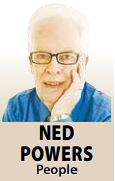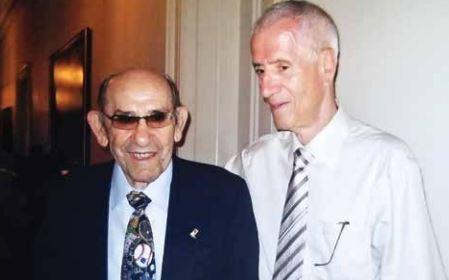
Emile Francis once shared the thought that during the years from 1948 into the 1960s, “it was the best baseball they ever had on the Canadian Prairies. Major league scouts often told us we were playing the equivalent of what was Double-A in the United States.”
Francis knew. He played and managed the North Battleford Beavers in Western Canadian semi-pro leagues from 1948 until 1960, often winning championships. Like many athletes in his day, he played baseball in the summer and professional hockey in the winter. His ability to lead men took him to the top in the National Hockey League, where he won 393 games as a coach and served as general manager of the New York Rangers, St. Louis Blues and Hartford Whalers.
Doug and Max Bentley were both National Hockey League scoring champions. They came from Delisle and often they would play 80 to 90 games in summer baseball, often twice as many games as they played in an NHL season. They were as good as most of the imports. One summer, they won 79 out of 80 games, and 25 of 26 tournaments.
Gordie Howe, one of the NHL’s greatest players, also knew baseball belonged on the Prairies. He could hit the ball a mile. But his career was limited. Jack Adams, general manager of the Detroit Red Wings, knew in the 1950s that Howe was a franchise NHLer. In an opinion considered very short-sighted by Prairie people, Adams banned Howe from playing competitive baseball or softball in the off-season. Howe loved both games, but listened to his hockey boss.
Spero Leakos was good friends with Francis, the Bentleys and Howe, and he knew how good our baseball game was. He grew up in a Saskatoon family, which supported sports. The family owned the Commodore restaurant on Second Avenue, and it became the favourite stopping place for all the travelling athletes, including the Pacific Coast teams which used to play in the Western Hockey League.

Cooperstown for Gillick’s induction into the
Baseball Hall of Fame. (Photo Supplied)
Spero was the happy host to them all. Because another Saskatoon restaurant owned the Gems semi-pro baseball team during the 1950s, Spero had to bide his time before introducing the Saskatoon Commodores. The 1961 team may have been Saskatoon’s best ever, with five of his American college players eventually making it into the major leagues.
Some of the riches which turned up on the Canadian Prairies, 1948 onwards, were the results of issues and influences across the border in the United States.
Jackie Robinson became the first African American player to enter the majors in 1947 but, by and large, organized baseball wasn’t very accepting. Black players became barnstormers into Canada. One of the leaders was George Ligon, from California, who brought an all-stars team to Saskatchewan in 1947. A landing spot was Indian Head. about an hour east of Regina. They changed the name of the team to the Indian Head Rockets, introduced a big money tournament with a $2,000 first prize which the Rockets often won. The team existed for seven years.
Two of the players shared in history-making. Tom Alston became the first African American to sign with St. Louis Cardinals, playing first base for them from 1954 until 1957. In 1959, Pumpsie Green became the first black player to sign with Boston Red Sox, and later played for the New York Mets. One of the best athletes on the Rockets was Rollie Miles. He stayed in Canada, joined the Edmonton Eskimos football team, starring from 1951 until 1961, winning all-star honours at three different positions and winning three Grey Cups.
Other American college players were also coming across the border to keep their games in shape. Ron Fairly turned up in Edmonton in 1953, Ron Perranoski in Lloydminster not long afterwards, and both made it into the majors with the Los Angeles Dodgers. Roy Taylor brought a college team, California Mohawks, and soon their talent was in demand by the Prairie teams.
The African American player with the best major league credentials was Don Buford, who played briefly with the North Battleford Beavers. He played nine years in the American League with Chicago White Sox and Baltimore Orioles, reaching three straight American League finals and winning the World Series in 1970.

The Americans, in essence, made the Saskatchewan homegrowns better. Mike Dayne, from a small town called Hodgeville, didn’t quite make into the majors, but the onetime North Battleford Beaver pitched 135 games in Triple-A. Dave Pagan, from an even smaller town named Snowden, reached the majors, including a pitching stint with the New York Yankees. The best of all was Terry Puhl from Melville, who played with the Houston Astros from 1977 until 1991 and had a lifetime batting average of .280.
Spero Leakos watched and learned and when the chance to have his own semi-pro team, the Commodores, no one in Saskatchewan ever did it better. Using mostly American college talent, Spero built teams in 1961 and 1963 “that ran away and hid from the rest of the Western League. Saskatoon still loved baseball and the great old Cairns Field facility, with 1,200 covered seats, in an Avenue A (Idylwyld Drive) location. The college players came up, played a 75-game schedules, with hardly a day off in the summer. Major league teams saw it as a feeder system.”
Five players from the 1961 team were up in the majors within five summers. Catcher John Boccabella signed with the Chicago Cubs, then went to the Montreal Expos and later to the San Francisco Giants, stretching it into a 10-year career. Shortstop Ernie Fazio signed with the Houston Astros and later played with the Kansas City Royals. Pitcher Dan Schneider took turns with the Milwaukee Brewers, the Atlanta Braves and the Houston Astros over a five-year period. Infielder Darrell Sutherland played with the New York Mets and the Cleveland Indians. It took infielder Tim Cullen a little longer to get there, but from 1966 to 1971, he played mostly for the Washington Senators and got to bat 1,800 times in the Bigs.
When the old Cairns Field closed, the new facility on a far-fromdowntown location didn’t have the same drawing appeal. Spero stuck with the league for another season. After that, until the early 1970s, his team played in the North Saskatchewan League. Three times Leakos took Saskatchewan teams into the national championships. Then, he became a charter member of the Saskatoon Senior Baseball League. The city’s respect for Spero was that it named the primary field in his honour.
In Spero’s Western Canada days, a rival on the field but good friend off the field, was Pat Gillick, who pitched for Edmonton.

picture taken with Ferguson Jenkins.
Gillick later was general manager of the Toronto Blue Jays, when they won back-to-back World Series championships in 1992 and 1993. He and Spero stayed in touch. When Spero decided to move away from Saskatoon in 2004, the baseball community honoured him with a banquet and Gillick came out to be the guest speaker.
When Gillick was elected into Baseball’s Hall of Fame in 2011, he invited Spero and his wife, Georgia, to be special guests at the ceremonies in Cooperstown. Spero had his picture taken with Robbie Alomar, Ferguson Jenkins, Tom Seaver and Yogi Berra, just like he was visiting a Field of Dreams.
While growing up in Saskatoon, there were certain things that steered Spero towards being a sports jock, and other things that led him into community involvement. He was only nine years old when his father, Steve, pulled off quite a coup on Oct. 30, 1937, when two National Hockey League teams, New York Rangers and New York Americans, played a doubleheader to open the new Saskatoon Arena. Both teams ate their suppers between games at the Commodore Café.
Spero said his dad sponsored and travelled with teams, and Spero would ride along in the car. When he reached Nutana Collegiate, he played basketball, baseball, soccer and participated in track and field. He was the senior watch. He was beginning to fulfill the dreams his parents, Steve and Agatha had for hm. Life at the restaurant was a natural for him. Mostly in a front-end and manager’s role, he was there from 11:30 a.m. until after the supper hours, often indulged in sports after supper, and then closed the restaurant for the night at midnight.
Basketball may have been the game he played best. He played in senior men’s league, coached, sponsored and officiated. He coached senior men’s softball before the baseball opportunities grew. His brother, Jim, played a handful of sports and ultimately, found a love as a race horse owner. His sister, Evangeline, played senior women’s basketball with the Adilman Aces.

What stood out for Spero’s friends was the way he’d jump into something like it was a rescue mission — basketball, softball, baseball and hockey. For two years, he hooked up the Bentley brothers, Doug and Max, to save the Saskatoon Quaker junior hockey franchise. He helped save the Saskatoon Gems as a communitybased semi-pro team until it finally became clear that the Commodores had to be his own special project.
When he and Georgia’s children were growing up, they loved sports. His sons, Tom and Michael, played for the baseball Cubs which Spero operated. One summer, when his boys were playing, he ran a senior baseball team and two teams on which the boys played. Another son, Steve, preferred track and field.
But the ultimate Spero story still had to do with baseball.
Georgia grew up in Los Angeles and Spero would visit. As Spero told it, “Georgia even got her engagement ring while we were on our way to Dodger Stadium in Los Angeles.”
They were married for 57 years.
Spero died in Calgary at the age of 92 on March 6, 2020.
-Ned Powers

Leave a Reply